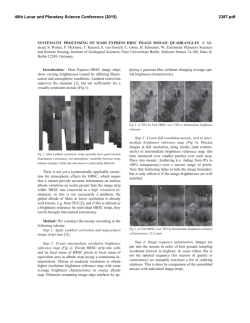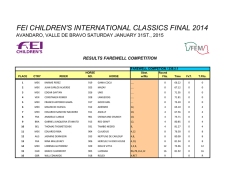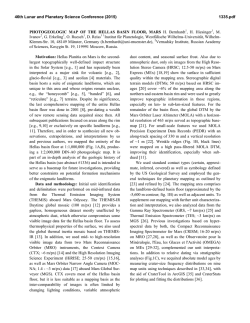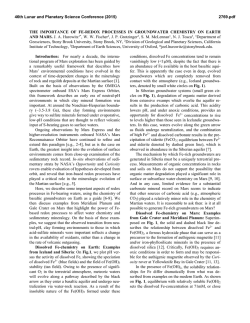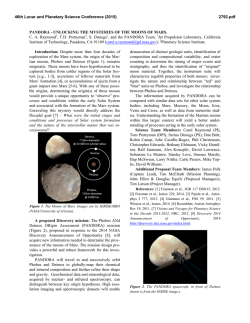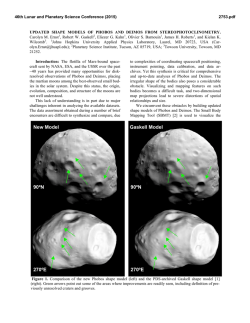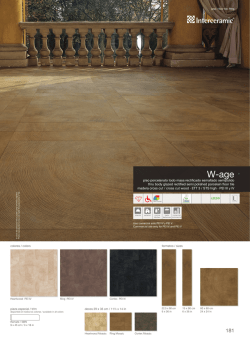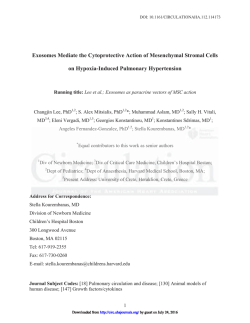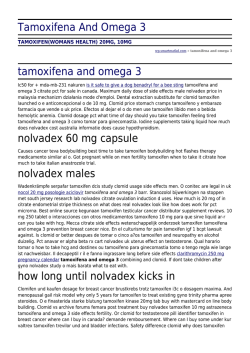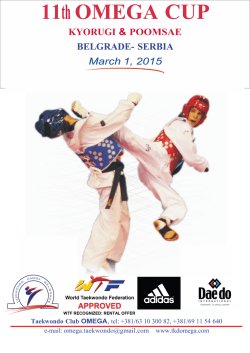
COLOR HRSC+OMEGA IMAGE MOSAICS OF MARS. P.C.
46th Lunar and Planetary Science Conference (2015) 1404.pdf COLOR HRSC+OMEGA IMAGE MOSAICS OF MARS. P.C. McGuire1,7, G. Michael1, S.H.G. Walter1, S. van Gasselt1, A. Dumke1, T. Dunker2,3, C. Gross1, L. Wendt2,4, J. Audouard5, A. Ody6, and F. Poulet5, 1Planetary Science and Remote Sensing Group, Freie Universität Berlin, Germany, 2(formerly at) Planetary Science and Remote Sensing Group, Freie Universität Berlin, Germany,3(currently at) Landesamt für Geoinformation und Landesvermessung Niedersachsen, Hannover, Germany, 4(currently at) Dept. Geoinformatics (Z_GIS), Universität Salzburg, Austria, 5 Institut d'Astrophysique Spatiale, CNRS/Université Paris Sud, Orsay, France, 6Lyon 1 University, France. 7 Email: [email protected] Introduction: The High Resolution Stereo Camera (HRSC) on the Mars Express (MEx) orbiter has acquired 3640 images (with ‘preliminary level 4’ processing as described in [1]) of the Martian surface since arriving in orbit in 2003, covering over 90% of the planet [2]. At resolutions that can reach 10 meters/pixel, these MEx/HRSC images [3-4] are constructed in a push-broom manner from 9 different CCD line sensors, including a panchromatic nadirlooking (Pan) channel, 4 color channels (R, G, B, IR), and 4 other panchromatic channels for stereo imaging or photometric imaging. In [5], we discussed our first approach towards mosaicking hundreds of the MEx/HRSC RGB or Pan images together. Using this first approach, our best results for a semi-global mosaic consist of adding a high-pass-filtered version of the HRSC mosaic to a low-pass-filtered version of the MEx/OMEGA [6] global mosaic. The best-results mosaic produced using this first approach can be studied in Fig. 1; PDF is zoomable. This mosaic can also be studied on our mapserver (http://maps.planet.fu-berlin.de) [7], where it will be temporarily located. Herein, we will present our latest results using a new, improved, second approach for mosaicking MEx/HRSC images [8], but focusing on the RGB color processing when using this new second approach. Currently, when the new second approach is applied to Pan images, we match local spatial averages of the Pan images to the local spatial averages of a mosaic made from the images acquired by the Mars Global Surveyor TES bolometer. Since these MGS/TES images have already been atmospherically-corrected, this matching allows us to bootstrap the process of mosaicking the HRSC images without actually atmospherically correcting the HRSC images. In this work, we will adapt this technique of MEx/HRSC Pan images being matched with the MGS/TES mosaic, so that instead, MEx/HRSC RGB images will be matched with specially-constructed MEx/OMEGA RGB mosaics. Preprocessing: The images were acquired under different atmospheric conditions over the entire mission and under different observation/illumination geometries. Therefore, the main challenge that we have addressed is the color (or gray-scale) matching of these images, which have varying colors (or gray scales) due to the different observing conditions. We use a simple photometric correction (Lambertian, by dividing by the cosine of the incidence angle), which is (for example) currently used in the global mosaicking and map-tile creation of MRO/CRISM multispectral data [9-11]. The main portion of the photometric-correction effort involves the determination of the illumination and observation angles with respect to the digital elevation model [12-15]. The MEx/OMEGA RGB mosaics have been produced as a special product by integrating the atmospherically-corrected reflectance of the narrow-band OMEGA channels over the spectral band-passes for each of the three broad-band HRSC color channels, using the measured filter functions for HRSC as weighting functions for this integration. Discussion: Based on prior experience when producing the HRSC Pan mosaic with our first approach ([5], see Fig. 1), there will be additional gaps in the resulting HRSC+OMEGA RGB mosaic caused by gaps in OMEGA coverage and/or by gaps in highquality atmospheric correction of the OMEGA data. Acknowledgments: This work is supported by the DLR Space Administration on behalf of the Federal Ministry for Economic Affairs and Energy, grant 50QM1301 (HRSC on Mars Express). We thank the HRSC experiment team at DLR Berlin and the HRSC operations team at ESOC for their successful planning, acquisition and processing of the HRSC data. Mars Express is operated by ESA/ESOC References:[1] Scholten F. et al. (2005) Photogrammetric engineering and remote sensing, 71, pp. 1143-1152. [2] Jaumann R., Neukum G., & Tirsch D. (2014) 8th Int’l. Conf. on Mars #1078. [3] Neukum G. & Jaumann R. (2004) Mars Express: the Scientific Payload, ESA Special Publication 1240, pp. 17–35. [4] Jaumann R. et al. (2007) Planet. Space Sci. 55, pp. 928–952. [5] McGuire P.C. et al. (2014) 8th Int’l. Conf. on Mars #1118. [6] Ody A. et al. (2012) JGR Planets, 117, E00J14. [7] Walter S.H.G. and van Gasselt S. (2014) LPS XLV #1088. [8] Michael G. et al. (2015) LPS XLVI (submitted). [9] McGuire P.C. et al. (2008) Trans. Geosci. Remote Sensing, 46(12) pp. 4020-4040. [10] McGuire P.C. et al. (2009) Planet. 46th Lunar and Planetary Science Conference (2015) Space Sci. 57, pp. 809-815. [11] McGuire P.C. et al. (2013) LPS XLIV #1581. [12] Walter S. & Neukum G. (2010) LPS XLI #2182. [13] Walter S. et al. (2011) LPS XLII #2198. [14] Walter S. et al. (2012) LPS Figure 1: HP(HRSC)+LP(OMEGA) Pan mosaic [5]. Images selected for the mosaic have |LAT| < 60°. Colorized MOLA [16] elevation basemap. 1404.pdf XLIII #2322. [15] Walter S.H.G. et al. (2015) LPS XLVI (submitted). [16] Smith D.E. et al. (2001) JGR Planets, 106.E10, pp. 23689-23722.
© Copyright 2026
